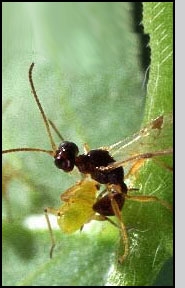Lygus bugs in the Sunday Sentinel
An interesting piece of local journalism this morning by Katrina Hunter, who has worked in agriculture on the Central Coast for a number of years. I remember speaking with her on some background for this article.
No disputing Lygus bugs in strawberries are a pretty major deal. I like the input from Charlie Pickett, who underlines that this is a native pest that has pretty well blown up because of the cropping systems we have brought with us. Strawberries are green and full of nourishment through our dry California summers, so while they aren't a preferred food they end up getting invaded every year. Alfalfa is way more attractive hence the concept of using a trap crop to hold them and mass them together for better efficacy of parasitization.
I remember releasing the first P. digoneutis with Charlie and Frank Zalom from UC Davis in some riparian areas surrounded by strawberries off of Blackie Road down south of Castroville. Plenty of cover and for sure plenty of lygus action over there- some of those guys took staggering losses in the late summers to this bug. I remember too the excitement when Charlie found a pupa of this parasitoid only one year after release. It was good, and hopes were high that this was really going to take off.
It's nice to see that there are areas with high rates of parasitization, but I want to caution people that this is certainly not the end of the Lygus story in strawberry. We are still dealing with plenty of Lygus bugs in strawberries (and increasingly caneberries and veg crops too), and along with biological control like what is described here, we very much need to continue work hard to develop and research the full constellation of tools to manage this pest and yes that does include chemicals. There are some pretty soft chemistries being researched right now, and in fact we have put forward, together with the Strawberry Commission, a Section 18 request for sulfoxaflor, a very promising chemistry with good efficacy and a good environmental profile.
Article is here. Nice job Katrina!

Peristenus digoneutis laying an egg in a plant bug nymph. Scott Bauer USDA/ARS.


It remains to be seen what Peristenus establishment will do to the density of Lygus region-wide long term, and what impact this will have in the future in strawberries, now already 15 years in.
It is important to point out that funding for biological control projects like the releases of Peristenus on the central coast of California have declined over the last 45 years, while the number of exotic invasions have increased 62 percent. The current rate is 10 species introductions per year.
https://webpages.scu.edu/ftp/kwarner/agBC-WarnerDeclineOfPublicInterestScience.pdf
All the best.
Posted by Katrina Hunter on April 22, 2018 at 7:19 PM